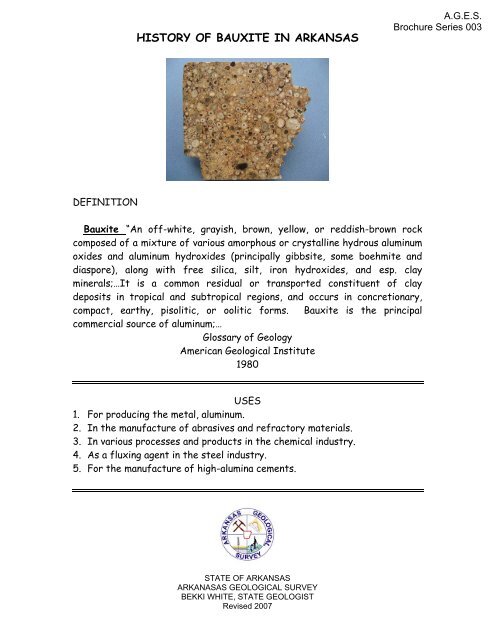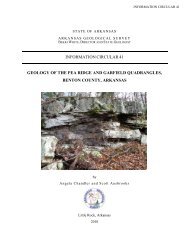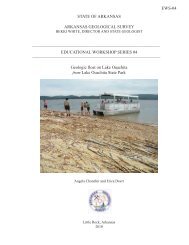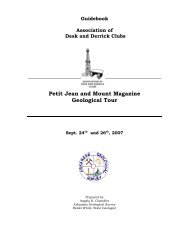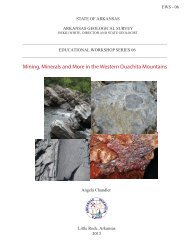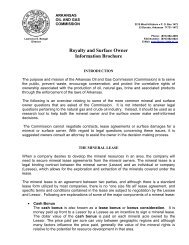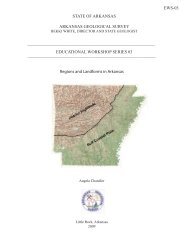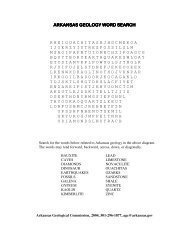HISTORY OF BAUXITE IN ARKANSAS - Arkansas Geological Survey
HISTORY OF BAUXITE IN ARKANSAS - Arkansas Geological Survey
HISTORY OF BAUXITE IN ARKANSAS - Arkansas Geological Survey
You also want an ePaper? Increase the reach of your titles
YUMPU automatically turns print PDFs into web optimized ePapers that Google loves.
<strong>HISTORY</strong> <strong>OF</strong> <strong>BAUXITE</strong> <strong>IN</strong> <strong>ARKANSAS</strong>A.G.E.S.Brochure Series 003DEF<strong>IN</strong>ITIONBauxite “An off-white, grayish, brown, yellow, or reddish-brown rockcomposed of a mixture of various amorphous or crystalline hydrous aluminumoxides and aluminum hydroxides (principally gibbsite, some boehmite anddiaspore), along with free silica, silt, iron hydroxides, and esp. clayminerals;…It is a common residual or transported constituent of claydeposits in tropical and subtropical regions, and occurs in concretionary,compact, earthy, pisolitic, or oolitic forms. Bauxite is the principalcommercial source of aluminum;…Glossary of GeologyAmerican <strong>Geological</strong> Institute1980USES1. For producing the metal, aluminum.2. In the manufacture of abrasives and refractory materials.3. In various processes and products in the chemical industry.4. As a fluxing agent in the steel industry.5. For the manufacture of high-alumina cements.STATE <strong>OF</strong> <strong>ARKANSAS</strong>ARKANASAS GEOLOGICAL SURVEYBEKKI WHITE, STATE GEOLOGISTRevised 2007
<strong>HISTORY</strong> <strong>OF</strong> <strong>BAUXITE</strong>Bauxite was first discovered by a French chemist, P. Berthier, in 1821 whileinvestigating specimens found near Les Baux in southern France. The rockname bauxite was not used until many years later.The development of the Bayer Process for the extraction of alumina frombauxite and the Hall process for the reduction of the alumina to metallicaluminum occurred during the period 1885 to 1890. As the metal aluminumbecame better known and its qualities recognized, many plants designed toutilize the Bayer and Hall processes were built.Pisolitic bauxite that is very loosely cemented.Bauxite in <strong>Arkansas</strong> was described in 1842 by Dr. W. Byrd Powell, who notedthe peculiar character of this rock in Fourche Cove but did not recognize its truenature. John C. Branner, State Geologist, was the first to identify bauxite whenhe noted it in a sample brought to him by Ed Wiegel of Little Rock in 1887. Thematerial was being used to surface the road from Sweet Home to Little Rock.Branner’s first published report of the occurrence of bauxite appeared in 1891.This was only a few years after the first discovery of bauxite in America at Rome,Georgia, and three years after the Pittsburgh Reduction Company had beenorganized to commercialize the Hall process of aluminum production.Active development began in 1895 with the purchase of land and mineralrights on large areas, and in 1896 the first 20 tons of ore were shipped. In 1898about 633 long tons of bauxite were mined to make aluminum. PittsburghReduction Company, a subsidiary of the Aluminum Company of America,2
entered the <strong>Arkansas</strong> bauxite field in 1899 and produced 1,720 tons of ore thatyear. In the same year the General Bauxite Company also shipped some ore.During the next three years the production remained low, but in 1903 it rose tomore than 25,000 tons. Production increased rapidly and reached nearly200,000 tons in 1914. World War I resulted in a remarkable increase, and morethan 560,000 tons were produced in 1918.Active mining at Bauxite, <strong>Arkansas</strong>, February, 2007.After the war, production dropped and oscillated from year to year. By 1923the total was back to nearly 500,000 tons. This tonnage represented about onehalf of the world production for that year. After 1923, increased production offoreign ore, particularly the high-grade ores from northern South America,caused a decline in <strong>Arkansas</strong> production so that in 1929 it composed only aboutone-fifth of the world’s production. Depressed economic conditions during theearly 1930’s reduced the output further, and in 1932 it was down to about 90,000tons. However, in subsequent years production figures began to rise again. Theall-time peak was reached during World War II when, in 1943, more than6,000,000 long tons were produced. Until 1942 the only company mining bauxitein <strong>Arkansas</strong> primarily for use in the manufacture of aluminum was a subsidiary ofthe aluminum Company of America [renamed the ALCOA Mining Company in1945]. Other companies, including the American Cyanamid & Chemical Corp.,the Norton Company, General Abrasive Company, Dulin Bauxite Company, andDixie Bauxite Company were mining bauxite for uses other than aluminum metal.In 1942, the Federal Government, through Metals Reserve Company,undertook to build a large stockpile of <strong>Arkansas</strong> bauxite as insurance against themenace of German submarines. Caribbean bauxite and South American3
sources were unavailable due to U-boat activity. The first contract was executedJanuary 30 with the Reynolds Mining Corporation, a subsidiary of ReynoldsMetals Company. An “open” schedule established by Metals Reserve in March,1942 brought numerous other mining firms into production in the district. Thefirst stockpile delivery was made May 15, 1942 by Dulin Bauxite Company.Very large pisolites in white matrix.Early in October of 1943, the War Production Board, in view of the improvedshipping situation, recommended reduction of stockpile deliveries to 250,000tons monthly, and a month later recommended that arrangements be made tofurther curtail deliveries so that by July 1, 1944 the stockpile would contain notmore than 2,000,000 tons. As a result, the small “independent” producers whohad been drawn into the field by the Government program ceased operation.Consequently, by the end of 1945 only ALCOA, Reynolds, and the group ofnonmetal producers active prior to 1942 remained as producers. War ProductionBoard orders in the latter part of 1943 likewise drastically curtailed operations ofall the larger producers. Since the end of World War II, Two major companiescontinued major mining operations in the bauxite area until 1991. ALCOA MiningCompany and Reynolds Metals Company had refineries located near Bryant, inSaline County. However, early in 1982 the Reynolds Company ceased operationof their mine. Reynolds closed and disassembled their Hurricane Creek Plantnear Bryant. ALCOA’s chemical facility remains in production. Several othercompanies have been active in <strong>Arkansas</strong> bauxite: American CyanamidCompany, Norton Company, Porocel Corporation, Stauffer Chemical Company,and A.P. Green Company. Between the end of the war and 1981, the last yearof available production, annual production has averaged nearly 1,700,000 longtons of bauxite.4
Since 1996 McGeorge Contracting Co. has been mining bauxite. The ore istrucked to Ft. Smith where it is processed to create proppants, which are highdensity spherical grains that are used in the oil and gas industry to fractureformations and maximize gas or oil flow.GEOLOGY <strong>OF</strong> <strong>ARKANSAS</strong> <strong>BAUXITE</strong>The bauxite deposits in <strong>Arkansas</strong> are associated with intrusions of nephelinesyenite in Pulaski and Saline Counties. They were formed by the lateriticweathering and leaching of silica from the aluminum-rich syenite when it wasexposed in the Tertiary. The deposits crop out on the surface but in most placesare covered by sands and clays of Tertiary age. Bauxite is essentially apaleosoil. Although some bauxite was mined underground, primarily during andimmediately after WW II, most production has been by open cut methods. Twogeneral types of bauxite are recognized: in situ (in place) and transported.BauxitematrixBauxitecobbleBauxitecobbleTransported bauxite showing bauxite cobbles within bauxite soil (matrix).USES <strong>OF</strong> <strong>ARKANSAS</strong> <strong>BAUXITE</strong>The principal use of <strong>Arkansas</strong> bauxite was in the manufacture of metallicaluminum. Present uses include the manufacture of artificial abrasive,chemicals, refractories, cements, absorbents, catalysts, and proppants.5
Bauxite Production in <strong>Arkansas</strong>, 1898 – 1981Year Long Tons Year Long Tons1898 633 1940 432,2831899 5045 1941 856,1961900 3445 1942 2,459,9061901 867 1943 6,036,4901902 4645 1944 2,695,3171903 25,713 1945 910,0491904 25,748 1946 1,050,3471905 32,956 1947 1,153,5631906 50,267 1948 1,395,3411907 58,942 1949 1,094,9241908 33,703 1950 1,307,3351909 101,531 1951 1,815,2741910 110,406 1952 1,603,8331911 122,133 1953 1,529,9761912 117,299 1954 1,949,3681913 169,871 1955 1,721,2431914 195,247 1956 1,668,4321915 268,796 1957 1,356,8981916 375,910 1958 1,257,9161917 506,556 1959 1,631,6431918 562,892 1960 1,932,0701919 333,490 1961 1,178,8981920 481,279 1962 1,270,1241921 124,850 1963 1,478,0471922 266,790 1964 1,561,9841923 498,880 1965 1,593,0851924 327,630 1966 1,781,3901925 296,320 1967 1,573,0001926 371,570 1968 1,582,0001927 303,830 1969 1,755,0001928 361,236 1970 2,227,0371929 351,054 1971 2,284,4201930 315,273 1972 1,960,0291931 286,620 1973 2,031,9321932 89,779 1974 2,124,2501933 142,179 1975 1,895,0651934 145,764 1976 1,667,0001935 219,791 1977 1,676,0001936 354,943 1978 1,446,0001937 402,195 1979 1,430,0001938 293,280 1980 1,299,0001939 361,256 1981*1,242,000*Last Year for which production figures are available.6
Uses of aluminumRECYCL<strong>IN</strong>G <strong>OF</strong> ALUM<strong>IN</strong>UMThe production of aluminum metal from bauxite requires huge amounts ofenergy -- much of it electrical while converting bauxite ore to metal, and whenreclaiming mined-out lands. Aluminum metal can be produced much moreefficiently (and economically) from salvaged aluminum, scrap because it requiresonly 5% as much energy to do so. As a consequence, the industry has steadilyincreased its use of scrap aluminum as a feedstock, and the general public hasparticipated enthusiastically in a nationwide recycling program for practical, __ andfor economic reasons. It pays to salvage used aluminum products! In 2004, as arecent example, about 3 million tons of aluminum metals were produced fromsalvaged scrap. This accounted for about 19 percent of the nation’s demand forthat year. Of this tonnage, about 40 percent was obtained from used beveragecans __ approximately 66 billion of them.RECLAMATION <strong>OF</strong> M<strong>IN</strong>ED LANDSAreas where bauxite was mined by open–cut methods after 1971 have to bereclaimed under <strong>Arkansas</strong> state law. Reynolds Metals Company has completedreclamation in their properties and ALCOA is reclaiming most of their formerbauxite mines. This task involves moving millions of tons of waste rock materialback into the large excavations created during mining. As the pits are beingpartially backfilled, the surrounding landscape is graded and shaped to providedrainage and eliminate high walls. At the conclusion of the needed earthwork,the top layer of the acid mine spoil is neutralized to create a new layer of soil forplant growth. The lands are then revegetated to prevent erosion. Reclaimedbauxite mines will be suitable for many different potential uses in the future,7
including a new community airport, wildlife habitat, recreational areas, andpasture land.Reclaimed area in Bauxite, <strong>Arkansas</strong>Written by William V. BushPhotos by Angela K. ChandlerFor more information contact the <strong>Arkansas</strong> <strong>Geological</strong> <strong>Survey</strong>at 501-296-18778


